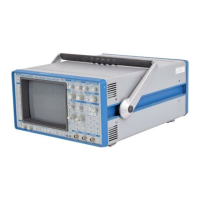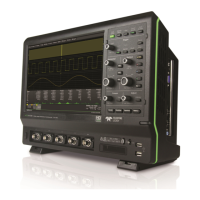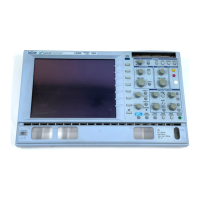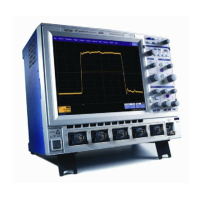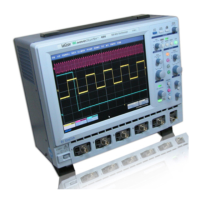FEATURES
Extensive Signal Averaging - Two operation
modes:
¯ Summation averaging up to 1,000,000 waveforms
¯ Continuous averaging with weighting factors up
to 128.
Averages up to 100,000 words/see in summation
mode.
Offset Dithering - Improves the vertical resolution
for low-noise measurements by several bits in
summation averaging mode. Reduces the effect of
ADC differential non-linearities.
Artifact Rejection - Rejects waveforms that
exceed the dynamic range of the ADC to ensure
statistical validity of summed average results.
"Extrema" Mode - Keeps track of time and ampli-
tude drift by storing extreme positive and negative
values, such as glitches, over a programmable
number of sweeps.
Powerful Arithmetic - Processes addition, subtrac-
tion, multiplication or division on pairs of wave-
forms stored in the 9400A’s memory locations
CH1, CH2, C, D and E. Waveform data can be nor-
malized by additive or multiplicative constants.
Complex Functions - Computes integration, dif-
ferentiation, square, square root and negation on
single waveforms stored in the 9400A memory loca-
tions CH1, CH2, C, D and E. Waveform data can be
multiplied by constants.
Smoothing - Allows two smoothing modes to
reduce unwanted noise on single events:
¯ Mean value smoothing down to 50 segments
¯ N-point smoothing with up to 9-point filter.
Vertical Expansion - Provides vertical scale expan-
sion by a factor of up to 10 in signal averaging
mode.
Chaining of Operations - Automatically chains two
operations.
Example: F(E) = Average (CH1-CH2).
An indefinite number of operations can be per-
formed sequentially, either manually or via remote
control.
Remote Control - Controls remotely all front-panel
settings, as well as all waveform processing options
via either GPIB or RS-232-C interfaces.
Color Archiving - Copies screen in color using a
wide range of digital plotters.
FUNCTIONAL DESCRIPTION
WP01, an optional waveform processing firmware
package for the 9400A Digital Oscilloscope, is opti-
mized for processing signals in real time. The
powerful 68000-based system permits rapid represen-
tation of processed results such as averages,
differentiations, multiplications, integrations and
smoothing of waveforms.
Waveform operations can be performed on live or
stored signals, or a combination of both. They are
selected through simple menus, and it is even pos-
sible to chain them and compute for example the inte-
gral of the multiplication of two traces, or average the
difference of CH1 and CH2.
WP01 includes an additional 512 kilobytes random
access memory for accumulation, computation and
waveform buffering. It permits the accumulation of up
to 1,000,000 waveforms of 32000 points each.
All processing occurs in waveform memories E and F
which may be displayed on the screen by pressing
FUNCTION E, F buttons. Whenever one of the FUNC-
TIONS E or F or their expansions (EXPAND A or B)
turned on, the corresponding waveform processing is
executed and the result displayed.
SIGNAL AVERAGING
WP01 offers two powerful, high-speed signal
averaging modes to improve signal-to-noise ratio and
provide more accurate measurements. Averaging
increases the dynamic range by several bits, allowing
the sensitivity to reach #Volts.
Summed averaging consists of the repeated addition,
with equal weight, of recurrences of the selected
source waveform. Whenever the required number of
waveforms is reached, the averaging process will
stop. The total number of waveforms to be accumu-
lated can be selected between 10 and 1,000,000
sweeps in a 1-2-5 sequence. Signals exceeding the
dynamic range of the 9400A’s 8-bit ADC at any point
may be automatically rejected to ensure valid summed
averaging results.
The user may also choose to ,,dither,, the program-
mable offset of the input amplifier. Dithering uses
slightly different portions of the ADC for successive
waveforms so that the differential non-linearities are
averaged. As a result, in a low-noise application, the
measurement precision and dynamic range are
improved.
Continuous averaging, sometimes called exponential
averaging, consists of the repeated weighted average
of the source waveform with the previous average.
This mode of averaging is a continuous process. The
effect of previous waveforms gradually tends to zero.
Relative weighting factors can be chosen from 1:1 to
1:127. This averaging mode is most useful for setting
up measurements or observing noisy signals that
change with time.
EXTREMA MODE
Tracking rare glitches or monitoring signals drifting in
time and amplitude is made easy with the unique
EXTREMA mode. The computation of extrema consists
of a repeated comparison of recurrences of the source
waveform with the accumulated extrema waveform.
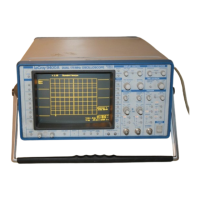
